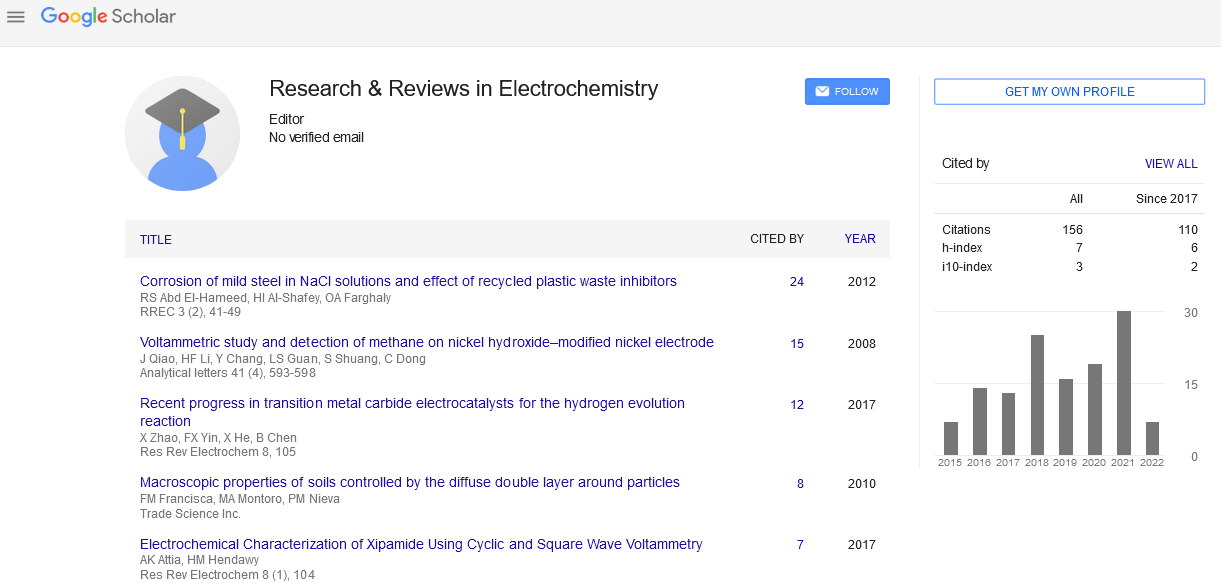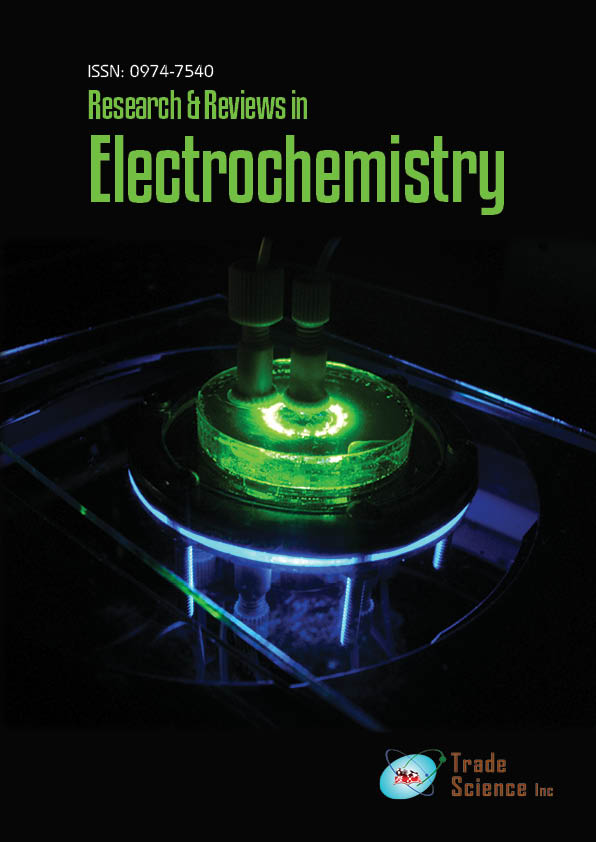Viewpoint
, Volume: 12( 1) DOI: 10.37532/0974-7540.22.12.1.235The Replacement of Electroplating
- *Correspondence:
- Sara Brown
Editorial Office, Research and Reviews in Electrochemistry, UK
E-mail: publisher@tsijournals.com
Received: 5-January-2022; Manuscript No. tsrre-22-64505; Editor Assigned: 19-January-2022; PreQC No. tsrre-22-64505 (PQ); Reviewed: 26- January-2022; QC No. tsrre-22-64505 (Q); Revised: 29-January-2022; Manuscript No. tsrre-22-64505 (R); Published: 31-January-2022, DOI No. 10.37532/0974-7540.22.12.1.235
Citation: Brown J. Recent Advances in Conducting Polymers: Applications in Electrochemistry. Res Rev Electrochem. 2022;12(1):234.
Abstract
With growing concern about the hazardous wastes generated by traditional metal finishing operations, there is a major push in the United States to replace "dirty" electroplating methods (particularly chrome and cadmium) with "clean" technology. While many corporations and military organisations continue to use less polluting electroplates, others are abandoning bath technologies entirely in favour of current high performance dry coating processes like as Physical Vapour Deposition (PVD), Chemical Vapour Deposition (CVD), and thermal spraying. Various dry alternatives to electrolytic hard chrome, such as PVD, plasma nitriding, high velocity oxyfuel (HVOF), laser CVD, and laser cladding, have been investigated for use in both original equipment manufacture and rebuilding worn components with funding from the US Defense Department's Advanced Research Projects Agency. In this work, hard chrome replacement is utilized to demonstrate the criteria for electrolytic coating replacement in general. Hard chrome replacements are being studied to verify that they not only function at least as well as the chrome they replace, but also fit with how the coated components are manufactured, utilized, and maintained. They must be dependable and cost-effective, and they must meet the demands of the end user over the coated component's full life cycle. HVOF, PVD, and duplex plasma-nitride PVD coatings show significant potential as replacements in a wide range of applications, including bearing surfaces, hydraulics, and ornamental finishes. Performance statistics along with cost evaluations demonstrate that these alternatives can be cost-effective chrome replacements.
Keywords
Electroplating; Physical vapor deposition
Introduction
Metal finishing activities are acknowledged as a major cause of pollution in the United States. Finishing activities including electroplating, conversion coating, and painting are becoming more scrutinized and regulated, raising their cost, complexity, and business risk. Indeed, in some parts of the country (particularly in California), municipal and regional environmental regulations have become so stringent that processes such as chrome plating have practically been forbidden. While this reduces pollution, it leaves enterprises and government agencies who rely on these well-established finishing technologies with the onerous task of finding appropriate cost-effective replacements.
Although Department of Defense (DOD) operations used to be mostly immune to environmental regulation and compliance, the situation has altered considerably in recent years. Military depots are now subject to the same environmental standards as most companies, and base commanders are being faced with personal liability for environmental concerns on their bases. Faced with lower funds and still compelled to clear up environmental pollutants from decades-old activities as well as comply with new rules to prevent future harm, the DOD is seeking for methods to carry out its operations cost-effectively in this new context.
Replacing such highly established technology necessitates considerably more than merely proving that newer alternatives can perform as well or better; any viable option must be compatible with DOD's whole manufacturing, maintenance, and repair system. To do this, the project team includes Original Equipment Manufacturers (OEM) (General Electric Aircraft Engines and Cummins Piston Ring Division), a military depot specialising in OEM product repair and maintenance (Corpus Christi Army Depot), and a DOD research and development laboratory (the Naval Research Laboratory).
The Advanced Research Projects Agency (ARPA) supported this effort to study hard chrome alternatives that may be utilized by DOD to lessen, and eventually remove, its substantial reliance on existing hard chrome-plating technology. The goal of this work is to utilize this to demonstrate the more general issues associated with changing electroplates.
Environmental issues associated with hard chrome plating
The principal issues with hard chrome plating are that it employs a hexavalent chrome solution and generates enormous amounts of hazardous chrome waste. While chromium metal and trivalent chrome are quite safe, hexavalent chrome in solution is a recognized human carcinogen that also causes distorted septa and skin and lung irritation. Hexavalent or trivalent baths can be used to deposit chrome. Because the technique is self-limiting and the deposition rate is limited, trivalent baths are only utilized for thin, ornamental chrome. Hexavalent solutions deposition at a faster rate and can be utilized to create thick coatings.
Electrolytic hard chrome plating, as it is now practised, causes a variety of environmental hazards.
(1) The following events result in direct human exposure: (a) Air emissions (bath mist produced by gas bubbles bursting); (b) skin contact (plating solution).
(2) Toxic wastes include the following: (a) spent plating solution; (b) bath drag-out (solution pulled from the bath on the parts); (c) spent acids and bases used in cleaning and stripping operations; (d) anode decomposition lead sulphate sludge; (e) waste rinse water (very large volumes of water are required for rinsing both parts and scrubbing filters); (f) contaminated mask material (typically wax or paint).
To dispose of its huge volumes of wasted solutions and contaminated water, the plating process must precipitate and evaporate all harmful elements, discharge the water to the sewage system, and send the solids to a toxic waste disposal. Toxic waste shipment and disposal are growing increasingly costly, putting businesses at risk of potentially disastrous future liability actions. Furthermore, waste processing failures regularly result in fines for unauthorized sewage discharges.
Hard chrome plating applications
Hexavalent chromium plating is mostly used for (a) strong, wear-resistant surface of machinery components and tools (e.g., valves, hydraulics, pumps, stamping dies, and moulds) and (b) ornamental purposes (automobile trim, office furniture etc.).
Hard chrome plating is widely used by military equipment manufacturers and depots engaged in repair and maintenance operations for (1) hard surfacing OEM components to reduce fretting, abrasion, and wear (e.g., landing gear, hydraulics, and turbine shafts), (2) as a dimensioning method for ensuring an accurate press fit in various engine components (e.g., bearing retainers and turbine blade discs), and (3) rebuilding worn parts in maintenance depots.
The DOD's criteria for wear-resistant surfaces are comparable to those of the private sector. However, the DOD's maintenance requirements differ significantly from those of regular business. Vehicles or aircraft are totally stripped, examined, and rebuilt during military maintenance operations.
Many components are expensive and difficult to replace when fleets of vehicles, planes, and ships age. As a result, hard chrome rebuilding is typically required in maintenance procedures, in which a thick (0.25 mm) hard chrome plate is placed to the worn region and machined back to the desired dimensions and surface polish. Because of its ease of application, wear resistance, and ability to create a flawless finish, hard chrome is employed. Prior to rebuilding, all old chrome must be removed, generally by anodic caustic or acid stripping, which generates a substantial amount of highly polluted waste that is not typically seen in commercial processing.
Alternatives to electroplating
When changing a coating technique such as hard chrome, there are a few fundamental questions to consider. It is uncommon, if ever, feasible to replace it with something that accomplishes precisely the same job. In fact, the entire system (substrate + coating + manufacturing technique) is frequently developed with the replacement coating in mind. To guarantee that the replacement makes excellent engineering and economic sense, a number of questions must be asked.
What exactly is the coating for? Its core use is vital, but it may also have secondary purposes. While the primary purpose of a hard chromium coating may be to rebuild a worn component with a wear-resistant layer, it may also be required to provide some corrosion resistance and lubricity.
What attributes does the replacement require to accomplish its functions? Thickness is frequently defined since it is a necessity of the present coating system, although it may be detrimental in the new system. A 125 micrometre chrome coating, for example, might easily be replaced with a 5 micrometre PVD coating provided the tougher PVD-coated component had a suitably low wear rate in the intended usage.
Is the new coating going to need a change in substrate material or component design? To be successful, a new PVD coating, for example, may require a tougher or more temperature resistant substrate. A thinner coating may need a modification to the prescribed dimensions or surface finish.
How will this adjustment affect the entire production process? Other procedures that impact the whole production process may be avoided or included in the modification. For example, the new process may eliminate the need for a grind or heat treatment, or it may necessitate a new retempering phase. Though expensive grinding procedures are avoided, the adoption of current techniques is frequently more cost-effective, even when the coating process is more expensive. These changes not only affect the cost structure of the production system, but they may also affect its material flow, material source, and manufacturing phases.
What is the actual cost of the procedure (both old and new)? It is critical to cost the complete manufacturing process, including research, source materials, coating, and finishing, rather than simply the coating portion. There might be hidden expenses in either the old or new process that are not shown by basic cost studies (waste disposal, risk, quality control, and so on).
It is not enough to merely propose an alternate coating technique with good wear or corrosion qualities. In our work, we have taken the approach that alternative coatings must be (a) clean (i.e. they must produce non-toxic discharges and only small amounts of non-toxic waste), (b) technically effective (the performance must at least equal that of the coating being replaced), (c) cost effective (life cycle cost must be comparable with (or better than) that of the electroplating technology), and (d) compatible with life-cycle use (e.g. rebuild coatings must be compatible with life-cycle use.
Waste streams
Although they eliminate all Cr6+ waste, methods like HVOF, PVD, plasma nitriding, laser cladding, and laser CVD do not. The volume of waste created is determined by criteria such as component size and form, machine loading, coated area size, component cleanliness, and so on. Surface cleaning or preparation is required for all current coating processes. As a result, all create some waste aqueous cleaner (primarily surfactant and oil contaminated water).
Conclusions
There are a variety of economically feasible manufacturing alternatives to hard chrome and comparable electroplates. In general, their performance will match, if not exceed, that of the coating they replace. Contrary to common belief, they are typically comparable in cost, if not less expensive, especially when enhanced performance and equivalent degrees of integration with the industrial environment are considered. This research has only analysed two of them (PVD and HVOF), but other methods may be equally helpful depending on the materials and end applications. However, caution should be exercised when extrapolating these findings. HVOF, PVD, and other current techniques will not always be less expensive or more efficient.
To effectively implement one of the contemporary coating choices, more than only performance or cost must be considered. There is rarely, if ever, a direct substitute. Other changes to the entire manufacturing process are likely to result from the introduction of a modern alternative to an electroplate, such as changes to the specified dimensions and materials, as well as changes to the precoating and finishing stages. Although these adjustments may be painful at the moment, they are likely to result in a better product at a cheaper cost in the long term, as well as a decrease in business risk and environmental harm.

